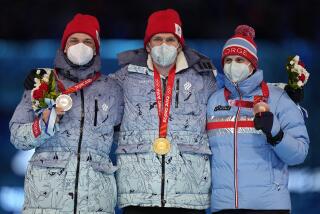Norway’s Strict Government Policies Help to Curtail Drug Use
- Share via
OTTAWA, Canada — The Norwegian approach to drug testing is, in a word, strict.
The United States, with a population of 230 million, tests an average of 2,500 athletes per year. Norway, with a population of 4 million, conducts 1,500 tests.
The system, called the Norwegian Model, was widely discussed at the First Permanent World Conference on Anti-Doping In Sport. It is the standard by which the rest of the world’s anti-doping schemes are measured. Very few even come close.
The Norwegians attack the drug problem aggressively, and from several different fronts. Foremost among these is testing.
--No-nonsense testing. The Norwegians conduct random, out-of-season, unannounced tests anywhere in the world. This means that if one discus thrower from Norway is training in the fall at a university in the United States, a drug-testing team can be dispatched and a test ordered.
There have been cases of Norwegian officials entering training rooms and conducting spot tests. The Norwegians recognize that athletes are using drugs such as anabolic steroids during training periods, not during competition. And certainly not at competitions where they know there will be testing.
Norway has had a national doping control program since 1976, under the Norwegian Confederation of Sports. At first, the program called for testing at competitions only, as most of the world does.
“We started out with competitive testing, but it was useless because everyone knew about it,” said Hans Skaset, President of the Norwegian Confederation of Sports. “That kind of testing has little effect. Too much money is being spent on testing that everyone knows about. It has very little effect--or no effect.”
About 75% of drug testing in Norway is out-of-competition and the bulk is done in sports in which drugs have been a problem.
The Norwegians have also been involved in the formation of a Nordic Anti-Doping Convention in 1983, which has been adopted by Norway, Sweden, Denmark, Iceland and Finland. In this document, the nations agree to cooperate by testing each other’s athletes on request. A similar agreement with Great Britain is in the works.
--Coordination with civil authorities. Four Norwegian government ministries cooperate to control the importation, distribution and use of banned drugs.
Sports officials cooperate with the police and the customs agency by alerting them when large delegations of athletes will be coming into the country or when Norwegian athletes return from extended stays in the United States, which has been identified as a perennial source for drugs.
In addition, border checks for anabolics are more frequent and more extensive.
“We want people to know that if they come to Norway with these drugs, that they will be caught and prosecuted,” said Harald Tronvik, of the Norwegian Confederation of Sports.
Helen Bosterud, the Norwegian Minister of Justice, has proposed legislation that would make the importation, distribution and recommendation of the use of banned drugs a criminal act. Punishment would be a large fine or imprisonment.
A national campaign to inform doctors, pharmacists and other health professionals about the danger of prescribing and selling anabolic steroids to athletes has caused the dispersal of steroids in Norway to fall sharply.
Bosterud said that authorities are marking an increasing relationship between the trafficking of anabolic steroids and the trafficking of narcotics.
“People have found out that there is money to be made in selling doping drugs,” she said. “We have found that prices are often 30 times higher (on the black market) than in a drugstore. Earnings are comparable to those in the illicit drug trade.”
Once drugs are brought into the country, officials map the distribution routes and note cities or athletic clubs that seem to be centers for drug sales.
The vigilance appears to have paid off. In 1985, customs officers seized about 2,000 anabolic steroid pills or capsules. In 1986, the figure increased to 200,000.
--Tough punishment. Any Norwegian athlete who is caught using anabolic steroids is suspended for two years in the first instance. The athlete is suspended for life if he is caught again.
Also, the Norwegian Olympic Committee has taken sanctions a step further. Any athlete testing positive for any banned substance will not be eligible to represent Norway in the Olympics.
“This is to stop the Games from being polluted from athletes who have contravened the Olympic rule,” Skaset said. “In some cases, athletes have been caught, suspended for 18 months and then they enter the Olympic arena and win medals. This is not reasonable.”
Persons caught trafficking banned substances have been suspended for five years in the first offense.
And, almost a final penalty, the individual federations withdraw sponsorship for any athlete who tests positive. No money, no drugs.
More to Read
Sign up for Essential California
The most important California stories and recommendations in your inbox every morning.
You may occasionally receive promotional content from the Los Angeles Times.














